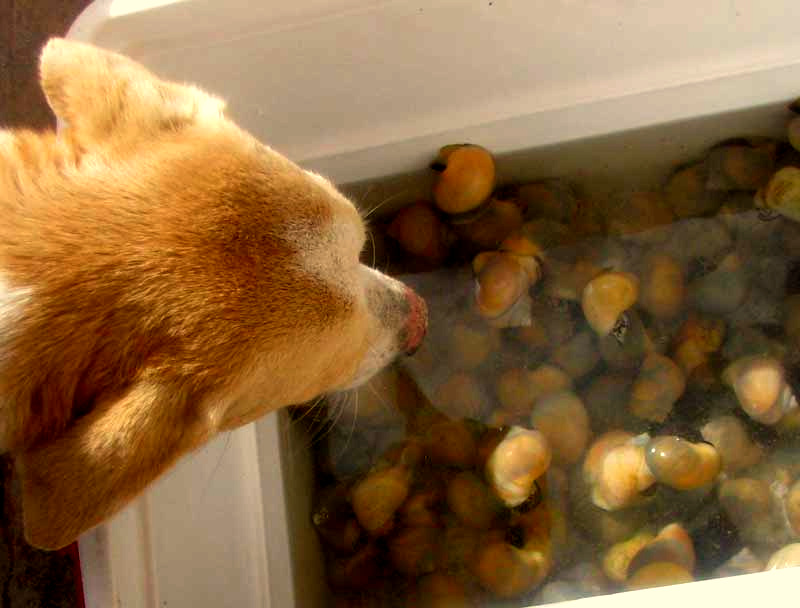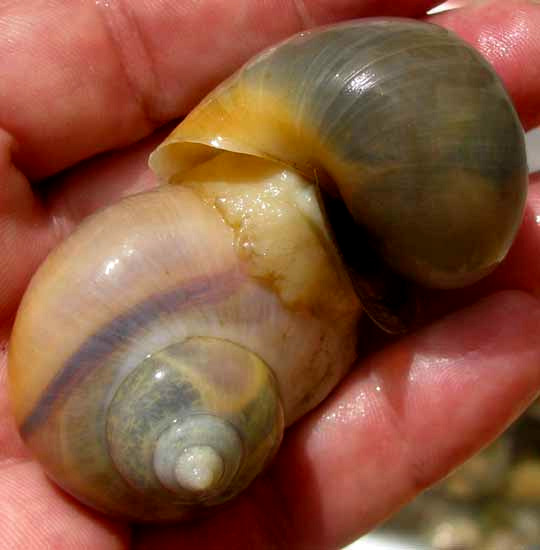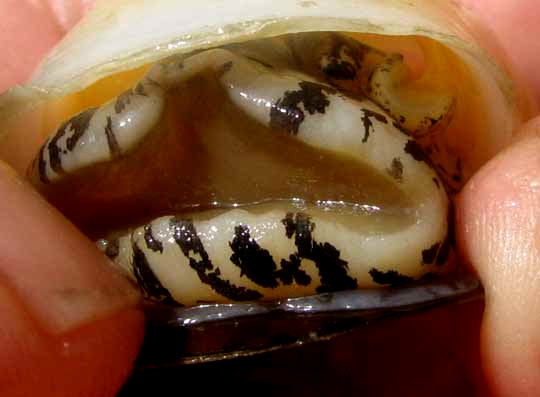Excerpts from Jim Conrad's
Naturalist Newsletter

from the October 9, 2011 Newsletter issued from Mayan Beach Garden Inn 20 kms north of Mahahual; Caribbean coastal beach and mangroves, ~N18.89°, ~W87.64°, Quintana Roo state, MÉXICO
APPLE SNAILS
The other day a visitor carried into the kitchen a cooler of snails he'd just gathered from nearby Lake Bacalar. He wanted them cooked. That's the snails above. In the picture that's Helado the Dog, the one I have to scratch each morning before I jog, nosing into the cooler. A close-up showing two 1-½-inch long snails (4cm) in my hand is below:

Some snails were white, some very dark, and some were white with splashy dark markings. With my fingers holding the "door," or operculum, of one snail open, its tiger-striped flesh could be seen, as shown below:

I'm assured that these are small ones, and read that they grow to about 2.3 inches across (6cm). A friend living in the town of Bacalar on the mostly-freshwater lake of Bacalar tells me that as a child she loved picking up buckets of such big, white snails and eating them raw along the banks, with lime juice. For the guests here the snails were cooked and served in ceviche, a dish typically made from fresh raw fish marinated in citrus juices such as lemon or lime and spiced with chili peppers and seasonings like onion, salt, cilantro, and pepper.
One name for these snails is the Mexican Apple Snail. In Spanish they're sometimes called Caracol Manzana Maya, or Mayan Apple Snail. They're POMACEA FLAGELLATA, found from Southern Mexico through Central America to northern Colombia. Several species of apple snail -- of the genus Pomacea -- are recognized.
Among conchologists, or mollusk experts, apple snails are thought of as tropical and subtropical, freshwater snails highly adapted for regions with well defined dry and wet seasons. One adaptation is the hard, smooth, close-fitting operculum that closes the shell's hole against drying when the snail withdraws into its shell. Apple snails also have a lung/gill combination for breathing, one for air, the other for water. They stay submerged during the day, hiding in vegetation near the bank and the surface or buried in the mud. During the night they may leave the water looking for fresh vegetation.
Apple snails are known for their edibility and some species are sold to aquarists, who say that more than anything they love to eat zucchini and leafy vegetables such as spinach and lettuce. There's a whole website dedicated just to apple snails at http://www.applesnail.net/.
A 1978 paper by Moholy-Nagy in the journal American Antiquity documents the management of apple snails as a significant food source by the ancient Maya in northern Guatemala.